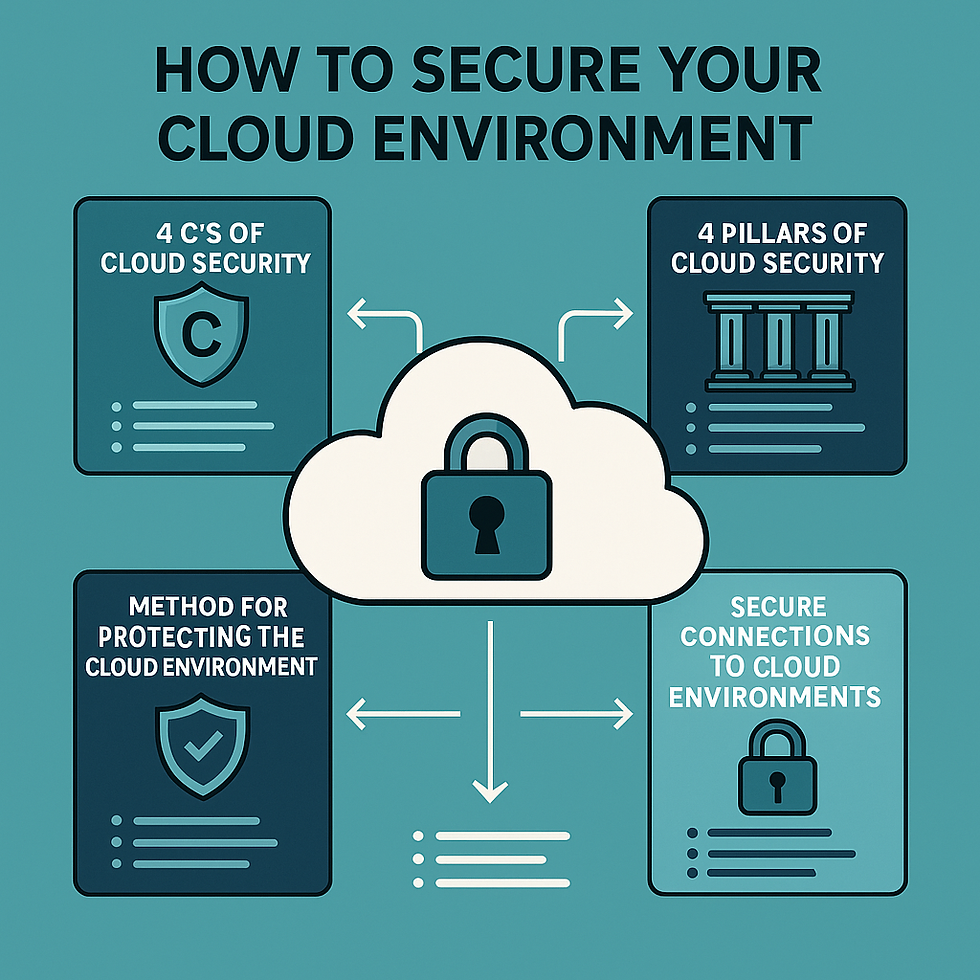How to Secure Your Cloud Environment
- Dr. Oludare Ogunlana

- Jul 15, 2025
- 3 min read

As organizations continue to migrate critical workloads to the cloud, the need for a robust and well-structured security framework becomes more urgent than ever. Cloud environments offer flexibility and scalability but also introduce complex risks across identity, data, configuration, and infrastructure. This article outlines key strategies for securing cloud environments and provides answers to frequently asked questions using industry-recognized tools and frameworks.
Understanding the 4 C’s of Cloud Security
The 4 C’s of cloud security—Control, Compliance, Configuration, and Continuity—serve as a foundational model for securing cloud assets.
Control involves implementing access policies, role-based access control (RBAC), and enforcing the principle of least privilege.
Compliance ensures that cloud deployments adhere to industry regulations such as GDPR, HIPAA, and PCI DSS.
Configuration covers hardening resources by eliminating misconfigurations, closing unused ports, and enforcing secure defaults.
Continuity addresses disaster recovery, data backups, and incident response capabilities to maintain resilience.
Each "C" contributes to a multi-layered defense-in-depth approach that mitigates security gaps and enables sustainable cloud operations.
Methods for Protecting Cloud Environments
Several techniques and tools help organizations protect cloud infrastructure from threats and vulnerabilities:
Cloud Security Posture Management (CSPM) tools like Azure Security Center help organizations detect misconfigurations, enforce security policies, and maintain compliance across hybrid and multi-cloud environments.
Cloud Workload Protection Platforms (CWPP) and Cloud Detection and Response (CDR) solutions such as Prisma Cloud provide real-time threat detection, vulnerability management, and compliance auditing from development through runtime.
Unified platforms such as CrowdStrike Falcon Cloud Security offer agent-based and agentless protection for infrastructure, containers, APIs, and cloud-native applications.
Combining these methods ensures that organizations have visibility and control across the entire cloud stack, from code to deployment.
The Four Pillars of Cloud Security
Cloud security can also be organized around four strategic pillars, each supporting secure operations at scale:
Identity and Access Management (IAM) – Use strong identity governance, multi-factor authentication (MFA), and conditional access to enforce the principle of zero trust.
Data Protection – Encrypt sensitive data at rest and in transit, manage cryptographic keys securely, and implement Data Security Posture Management (DSPM) solutions.
Infrastructure Protection – Secure virtual machines, storage, and networking by applying baseline configurations, micro-segmentation, and patch management.
Threat Protection and Monitoring – Employ continuous threat detection using advanced security analytics, threat intelligence, and Security Information and Event Management (SIEM) systems.
These pillars serve as a blueprint for managing risk and aligning with best practices across cloud platforms.
Achieving Secure Connections to Cloud Environments
A secure connection to the cloud is fundamental for protecting data in motion and securing administrative access:
All communications should be encrypted using TLS/SSL protocols.
Implement private connectivity mechanisms such as VPNs, Azure Private Link, or VPC peering to isolate management traffic from the public internet.
Enforce zero-trust network architecture, ensuring that no user or device is inherently trusted.
Use secure bastion hosts and jumpboxes for administrative access to production workloads.
Regularly rotate and manage certificates using centralized key management tools like Azure Key Vault.
By combining secure connectivity practices with monitoring and access control, organizations can reduce attack surfaces and protect critical assets.
How OSRS Can Support Your Cloud Environment
ÒGÚN Security Research and Strategic Services (OSRS) offers comprehensive support for organizations seeking to secure, manage, and optimize their cloud environments. Our team of experts provides tailored cloud security assessments, helping identify misconfigurations, compliance gaps, and vulnerabilities across AWS, Azure, and Google Cloud platforms. Leveraging leading frameworks such as NIST 800-53, CIS Benchmarks, and the AWS Well-Architected Framework, OSRS implements best-in-class security controls, identity and access governance, and data protection strategies. We also offer cloud incident response planning, continuous monitoring integration, and zero trust architecture design to strengthen resilience and reduce operational risk. Whether transitioning to the cloud or enhancing existing infrastructure, OSRS ensures that organizations maintain a secure, compliant, and cost-effective cloud posture aligned with business goals.
Conclusion
Securing a cloud environment involves more than just deploying tools—it requires a strategy built around best practices, continuous monitoring, and well-integrated platforms. Tools like Azure Security Center, Prisma Cloud, and CrowdStrike Falcon Cloud Security help organizations automate and scale their cloud security initiatives. By addressing core principles and engaging with expert support from OSRS, organizations can effectively secure their cloud environments against evolving threats.




Comments